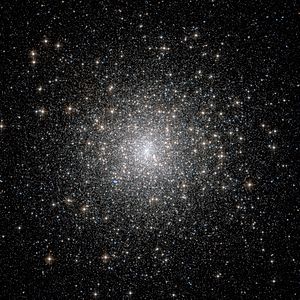- Messier 15
-
Messier 15 
M15 photographed by HST. The planetary nebula Pease 1 can be seen as a small blue object to the lower left of the core of the cluster.Observation data (J2000 epoch) Class IV Constellation Pegasus Right ascension 21h 29m 58.38s[1] Declination +12° 10′ 00.6″[1] Distance 33.6 kly (10.3 kpc) Apparent magnitude (V) +6.2 Apparent dimensions (V) 18′.0 Physical characteristics Radius ~88 ly[2] VHB 15.83 Estimated age 13.2 Gyr Notable features steep central cusp Other designations NGC 7078, GCl 120[1] See also: Globular cluster, List of globular clusters Messier 15 or M15 (also designated NGC 7078) is a globular cluster in the constellation Pegasus. It was discovered by Jean-Dominique Maraldi in 1746 and included in Charles Messier's catalogue of comet-like objects in 1764. At an estimated 13.2 billion years old, it is one of the oldest known globular clusters.
Contents
Characteristics
M15 is about 33,600 light-years from Earth, and 175 light years in diameter.[3] It has an absolute magnitude of -9.2, which translates to a total luminosity of 360,000 times that of the Sun. Messier 15 is one of the most densely packed globulars known in the Milky Way galaxy. Its core has undergone a contraction known as 'core collapse' and it has a central density cusp with an enormous number of stars surrounding what may be a central black hole.[4]
Home to over 100,000 stars,[3] the cluster is notable for containing a large number of variable stars (112) and pulsars (8), including one double neutron star system, M15 C. M15 also contains Pease 1, the first planetary nebula discovered within a globular cluster[5] in 1928. Just three others have been found in globular clusters since then. [1]
Amateur astronomy
At magnitude 6.2, M15 approaches naked eye visibility under good conditions and can be observed with binoculars or a small telescope, appearing as a fuzzy star.[3] Telescopes with a larger aperture (at least 6 in./150 mm diameter) will start to reveal individual stars, the brightest of which are of magnitude +12.6. The cluster appears 18 arc minutes in size.[3]
X-ray sources
Earth-orbiting satellites Uhuru and Chandra X-ray Observatory have detected two bright X-ray sources in this cluster: Messier 15 X-1 (4U 2129+12) and Messier 15 X-2.[6][7] The former appears to be the first astronomical X-ray source detected in Pegasus.
Images
-
The central square arcminute of M15 imaged using the lucky imaging technique
See also
- X-1 X-ray source
- X-ray astronomy
References
- ^ a b c "SIMBAD Astronomical Database". Results for NGC 7078. http://simbad.u-strasbg.fr/Simbad. Retrieved 2006-11-16.
- ^ distance × sin( diameter_angle / 2 ) = 88 ly radius
- ^ a b c d http://www.astropix.com/HTML/SHOW_DIG/M15_Pease1.HTM
- ^ Gerssen, J; van der Marel, R P; Gebhardt, K; Guhathakurta, P; Peterson, R C; Pryor, C (2003). "Hubble Space Telescope Evidence for an Intermediate-Mass Black Hole in the Globular Cluster M15. II. Kinematic Analysis and Dynamical Modeling". Astronomical Journal 125 (1): 376–377. arXiv:astro-ph/0210158. Bibcode 2003AJ....125..376G. doi:10.1086/345574. http://iopscience.iop.org/1538-3881/125/1/376/pdf/1538-3881_125_1_376.pdf.
- ^ Cohen, J. G.; Gillett, F. C. (1989). "The peculiar planetary nebula in M22". Astrophysical Journal 346: 803–807. Bibcode 1989ApJ...346..803C. doi:10.1086/168061.
- ^ Forman W, Jones C, Cominsky L, Julien P, Murray S, Peters G (1978). "The fourth Uhuru catalog of X-ray sources". Astrophysical Journal Supplement Series 38: 357. Bibcode 1978ApJS...38..357F. doi:10.1086/190561.
- ^ White NE, Angelini L (2001). "The discovery of a second luminous low-mass X-ray binary in the globular cluster M15". Astrophysical Journal Letters 561 (1): L101–5. arXiv:astro-ph/0109359. Bibcode 2001ApJ...561L.101W. doi:10.1086/324561.
External links
- Messier 15, SEDS Messier pages
- Messier 15, Galactic Globular Clusters Database page
- Globular Cluster Photometry With the Hubble Space Telescope. V. WFPC Study of M15's Central density Cusp
- Wikisky.org SDSS image of M15
- Messier 15 on WikiSky: DSS2, SDSS, GALEX, IRAS, Hydrogen α, X-Ray, Astrophoto, Sky Map, Articles and images
Messier objects List M1 · M2 · M3 · M4 · M5 · M6 · M7 · M8 · M9 · M10 · M11 · M12 · M13 · M14 · M15 · M16 · M17 · M18 · M19 · M20 · M21 · M22 · M23 · M24 · M25 · M26 · M27 · M28 · M29 · M30 · M31 · M32 · M33 · M34 · M35 · M36 · M37 · M38 · M39 · M40 · M41 · M42 · M43 · M44 · M45 · M46 · M47 · M48 · M49 · M50 · M51 · M52 · M53 · M54 · M55 · M56 · M57 · M58 · M59 · M60 · M61 · M62 · M63 · M64 · M65 · M66 · M67 · M68 · M69 · M70 · M71 · M72 · M73 · M74 · M75 · M76 · M77 · M78 · M79 · M80 · M81 · M82 · M83 · M84 · M85 · M86 · M87 · M88 · M89 · M90 · M91 · M92 · M93 · M94 · M95 · M96 · M97 · M98 · M99 · M100 · M101 · M102 · M103 · M104 · M105 · M106 · M107 · M108 · M109 · M110See also  Book:Messier objects ·
Book:Messier objects ·  Category:Messier objects
Category:Messier objects  Portal:AstronomyCategories:
Portal:AstronomyCategories:- Globular clusters
- Pegasus constellation
- Messier objects
- NGC objects
- Astronomical X-ray sources
- X-ray astronomy
-
Wikimedia Foundation. 2010.


